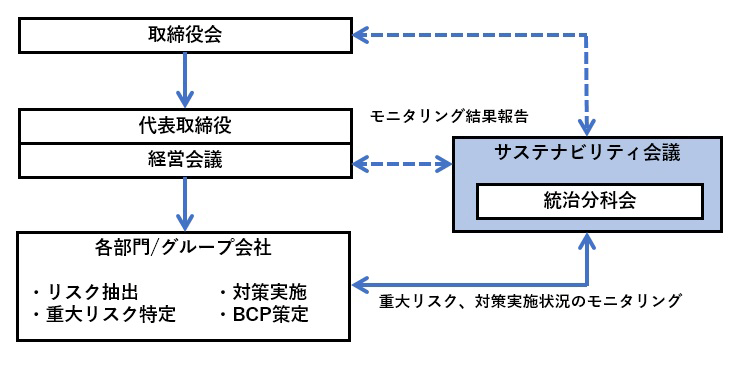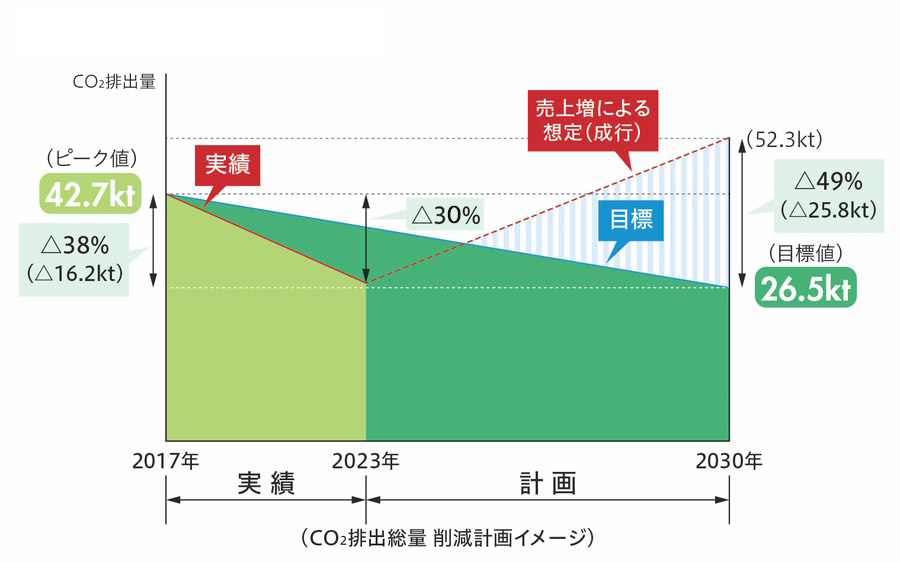Endorsement of TCFD recommendations and related information disclosure
In support of the purpose of the TCFD recommendations to proactively disclose financial information related to climate change, ShinMaywa Industries disclosed information based on the recommendations in January 2023.
Going forward, we will continue to utilize the framework of the TCFD recommendations to enhance the quality and quantity of information disclosure, and at the same time, contribute to the realization of sustainable society by further promoting initiatives toward climate change.
1. Governance
The Board of Directors chaired by President & CEO is responsible for the supervision and deliberation of climate-related risks and opportunities, considering them as important issues and themes related to corporate management. The Board of Directors’ meetings of the Company are held once a month, in principle, to discuss and consider important management issues including climate change based on the medium-term management plan and to monitor the execution of duties by Board members and executive officers.
Aiming to sustainably enhance corporate value and create social value, the Company holds Sustainability Committee meetings twice a year. The Committee is chaired by the President and composed of members including internal directors, executive officers of the Head Office, and presidents of divisions. It works to appropriately grasp and evaluate important sustainabilityrelated information and recommends measures for improvement.
Climate-related risks and opportunities are also being addressed within this framework as one of the key issues and the Committee monitors developments of such risks and opportunities.

2. Strategy
Given the significance of the potential impact that climate change may have on the business of the Company as well as long-term uncertainty, the Company conducts scenario analyses as a process to identify and assess climate risks and opportunities relevant to its business.
Of the five businesses, scenario analyses were conducted for two of the businesses in fiscal 2022: special purpose truck and fluid. In fiscal 2023, analyses were conducted for the remaining three businesses: parking systems, industrial machinery and environmental systems, and aircraft.
The Company identified climate risks and opportunities based on two assumed scenarios for the world outlook: the 1.5/2.0 degrees Celsius scenario of globally achieving net zero by 2050 and the 4.0 degrees Celsius scenario of facing more extreme weather events and more serious disasters due to changing climate as a result of prioritizing economic activities.
The specific processes and results of the scenario analysis are provided below.
In addition, the results of these climate-related scenario analyses are reflected in our medium-term management plan [SG-2026], which began in fiscal 2024, and are being implemented in the Business strategies of each business division.
- <Scenario Analysis Process>
-

- <Scenario Analysis Result>
| Scenario | Changes in the external environment | Scenario analysis results | Time of manifestation | |||
|---|---|---|---|---|---|---|
| 1.5℃/2.0℃
scenario |
・Strengthening regulations on GHG emissions ・Transition to low-carbon technologies ・Changes in market structure |
Risks |
Common |
|
Mid to long term |
|
|
专用车 |
|
Mid to long term |
||||
|
Parking |
|
Mid to long term |
||||
|
Mid-term |
|||||
|
Industrial Machinery & |
Mechatronics |
|
Mid-term |
|||
|
Mid to long term |
|||||
|
Envrionment |
|
Mid to long term |
||||
|
Long-term |
|||||
|
流体 |
|
Mid to long term |
||||
|
飞机 |
|
Mid to long term |
||||
|
Opportunity |
专用车 |
|
Mid to long term |
|||
|
Parking |
|
Mid-term |
||||
|
Mid to long term |
|||||
|
Industrial Machinery & |
Mechatronics |
|
Mid to long term |
|||
|
Envrionment |
|
Mid to long term |
||||
|
流体 |
|
Mid to long term |
||||
|
飞机 |
|
Mid to long term |
||||
|
Short to long term |
|||||
| 4.0℃ scenario |
- Intensification of meteorological disasters such as heavy rains, floods, and typhoons |
Risks |
Common(*) |
|
Long-term |
|
|
Opportunity |
专用车 |
|
Short to long term |
|||
|
Parking |
|
Mid to long term |
||||
|
Industrial Machinery & |
Mechatronics |
|
Mid to long term |
|||
|
Envrionment |
|
Mid to long term |
||||
|
流体 |
|
Mid to long term |
||||
|
飞机 |
|
Mid to long term |
||||
- Time horizon definitions
Short term: by 2023; medium term: by 2030; long term: by 2050 - Scenarios used
1.5/2.0 degrees Celsius scenario: IEA Energy Outlook, the 2.0 degrees Celsius scenario (RCP2.6) of the IPCC Fifth Assessment Report
4.0 degrees Celsius scenario: IPCC Sixth Assessment Report, the 4.0 degrees Celsius scenario (RCP8.5) of the IPCC Fifth Assessment Report
3. Risk Management
With regard to risks associated with business operations, the Company established the ShinMaywa Group Risk Management Rules. Under these Rules, each of the divisions and Group companies is taking the initiative to build risk management systems suitable for their business characteristics. In addition, the Head Office monitors the status of risk management by those divisions and group companies and implements company-wide measures against risks, including disaster and financial risks, thereby establishing risk management systems.
The Sustainability Committee checks the establishment of risk management systems and activities in the ShinMaywa Group based on information reported by the Head Office and business divisions. The Committee also identifies company-wide key risks in light of their impact on business operations and reports such information to the Executive Committee and the Board of Directors on a regular basis to ensure the effectiveness of risk management in the group.
As for climate change, the Company has conducted scenario analyses for the first time in FY2022, covering two businesses, as a process to identify and assess climate risks and opportunities relevant to its businesses, given the significance of the potential impact that climate change may cause to its businesses, as well as long-term uncertainty. Under the company-wide risk management framework described above, the Company will manage climate risks and opportunities of special important, among those identified by the scenario analysis.

4. Metrics and Targets
As a medium-term greenhouse gas reduction target through 2030, the Company is currently working to achieve the target of “reducing total CO2 emissions from energy use by 38% in FY2030 (compared to FY2017).” This means that the Company will reduce CO2 emissions from energy use from 42,720t-CO2e in FY2017 to 26,486t-CO2e in FY2030 on an actual result basis.
Actual results of Scopes 1 and 2 emissions in the past (non-consolidated) are as shown in the table below. Emissions from major consolidated subsidiaries in Japan and overseas are calculated and added from FY2024 onwards.
Scope 3 emissions have been calculated only on a nonconsolidated basis, but we plan to promote an initiative to calculate emissions including those from consolidated subsidiaries in the future.
Total CO2 emissions reduction plan (non-consolidated)

Scope 1 and Scope 2 emissions (non-consolidated)
| Base year | Past 5 years performance | Target standard | |||||
|---|---|---|---|---|---|---|---|
| management indicators | FY2017 | FY2020 | FY2021 | FY2022 | FY2023 | FY2024 | FY2030 |
| Scope1 | 11,754 | 10,528 | 9,796 | 9,494 | 9,474 | 8,839 | ― |
| Scope2 | 30,966 | 20,321 | 20,682 | 17,918 | 19,918 | 18,007 | ― |
| Scope1+2 | 42,720 | 30,849 | 30,478 | 27,412 | 29,392 | 26,846 | 26,486 |
- *1Aggregate figures of ShinMaywa Industries on a non-consolidated basis
Scope 1, Scope 2 emissions (domestic consolidated)
| management indicators | FY2023 | FY2024 |
|---|---|---|
| Scope1 | 12,442 | 12,236 |
| Scope2 | 28,686 | 31,172 |
| Scope 1 + Scope 2 total | 41,128 | 43,408 |
Major consolidated subsidiaries that were included in the calculation

Scope 3 emissions (non-consolidated)
| Categories | FY2023 | FY2024 | |
|---|---|---|---|
| 1 | Purchased products and services | 605,545 | 602,090 |
| 2 | Capital Goods | 10,794 | 12,419 |
| 3 | Fuel and energy-related activities not included in Scope 1 and 2 | 4,520 | 4,118 |
| 4 | Transportation and distribution (upstream) | 3,158 | 3,279 |
| 5 | Waste generated from business activities | 825 | 1,099 |
| 6 | Business trip | 423 | 450 |
| 7 | Employee commuting | 1,153 | 1,220 |
| 8 | Leased assets (upstream) | Not applicable | Not applicable |
| 9 | Transportation and distribution (downstream) | Not applicable | Not applicable |
| 10 | Processing of sold products | Not applicable | Not applicable |
| 11 | Use of sold products | 1,262,255 | 1,327,728 |
| 12 | Disposal of sold products | 1,413 | 1,650 |
| 13 | Leased assets (downstream) | Not applicable | Not applicable |
| 14 | Franchise | Not applicable | Not applicable |
| 15 | Investment | Not applicable | Not applicable |
| Total | 1,890,086 | 1,954,053 | |
